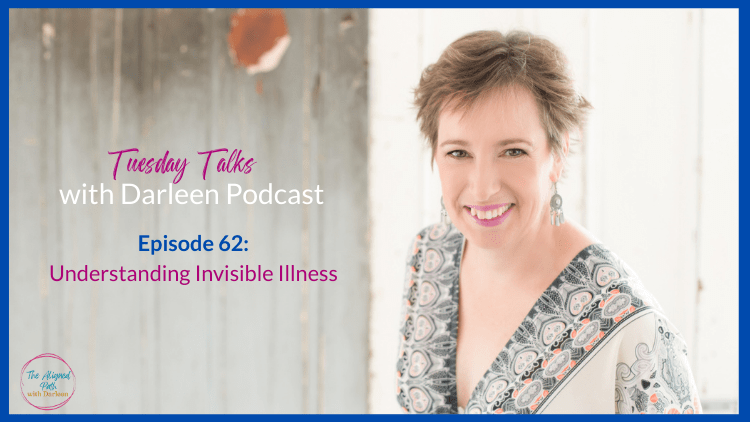This is a question I’ve been asked many times, and I love that people are starting to ask it more. It’s such an important conversation, especially because invisible illnesses are so easy to misunderstand when you’re not living with one. The simplest way I explain it is this: it’s something real that you can’t see.
There’s no cast, no scar, no bandage. There’s nothing obvious on the outside. But what someone is going through can affect every part of their day. And that’s what makes it invisible. And often, isolating.

EPISODE 62: Listen using the player below, or click the links to your fave platform to subscribe and listen over there:
Understanding What Can’t Be Seen
When someone is dealing with an invisible illness, their energy is different. It’s not about being lazy or dramatic. Some days, even getting out of bed and walking to the bathroom is a huge effort. That’s the level of exhaustion or mental load that can be happening behind the scenes.
The hard part is that a lot of the advice people give doesn’t land, because they can’t see what’s really going on.
- Suggestions like “just go outside” or “have a shower” are often said with care, but they can feel heavy when your energy is already depleted.
- Comments like “you just need a good meal” or “go for a walk” don’t take into account what the body is actually capable of that day.
- Most people mean well, but when they don’t understand the full picture, their support can come out as pressure instead of presence.
This is why it’s so important to speak about invisible illness with gentleness and clarity, so more people know what it really means and how to be there for the people they care about.
Common Types of Invisible Illness
There are so many different types of invisible illness. For some, it’s mental health. For others, it’s autoimmune or hormonal. And often, it’s a combination of things that can’t be seen from the outside but are absolutely real and valid.
- Autoimmune conditions can impact the entire body, draining energy and causing chronic symptoms even when someone looks “fine.”
- Thyroid issues can affect heart rate, mood, and metabolism. If it’s overactive, the body runs in overdrive. If it’s underactive, everything slows down.
- Hormonal imbalances, including issues with the pituitary gland, can completely shift how someone feels in their body and mind.
None of these show up with a brace or a scar. But they affect everything, from how much someone can do in a day to how they feel in themselves.
The Reality of Delayed Diagnosis
One of the hardest parts of invisible illness is that it can take a long time to be recognised or diagnosed. I’ve seen this so often, especially with women. There’s still a bias that can lead to symptoms being dismissed or explained away. And that means people are often left waiting, wondering, and trying to manage something that hasn’t even been named yet.
It’s not uncommon for someone to be passed from doctor to doctor before they finally get an answer. And while that’s happening, they’re also navigating the day-to-day exhaustion of living with something that hasn’t been acknowledged yet. That takes a toll, physically, emotionally, and mentally.
Learning to Work With Your Energy
When you’re living with something invisible, energy management becomes essential. You start noticing when your body is most alert, when it’s time to rest, and how much you can realistically do in a day. It’s not about being limited, it’s about being wise.
- I’ve learned that mornings are best for the things that require more focus, like recording content or doing deeper work in my business.
- Client sessions and podcast interviews can happen later, when my energy is still good but less mentally demanding.
- I also honour my end time. I wrap up at four, because I know how much my body can hold. If I push past that, I feel it.
This kind of awareness helps you keep going without crashing. It’s not always perfect, but it creates rhythm, and that rhythm is everything when you’re working with an invisible illness.
How to Support Someone With an Invisible Illness
If you’re not sure how to support someone living with an invisible illness, here’s what helps most: be present, be specific, and don’t make them work harder to ask for what they need.
- Instead of asking “What can I do?”, look around and offer something specific, like vacuuming, doing the dishes, or putting on a load of washing.
- Understand that their brain might not be firing on all cylinders that day. Giving them options, or doing what’s clearly needed, is such a gift.
- You don’t always have to talk. Just sitting with someone, reading a book next to them, or being quiet company can mean more than words.
Support doesn’t have to be grand. It just has to be thoughtful. And when it comes from a place of care rather than pressure, it makes all the difference.
Here for the links that may have been referenced in the show or is complementary to this episode.
- Podcast – Ep 76: Invisible Illness and Compassionate Business
- Podcast – Ep 29: Bec Waterhouse
- Podcast – Ep 17: Emma
More in-depth content and resources:
- Blog Post – Creating Emotional Safety in Entrepreneurship




